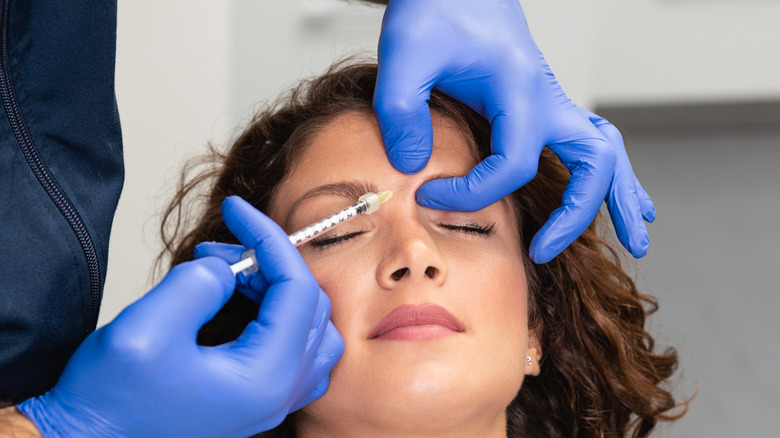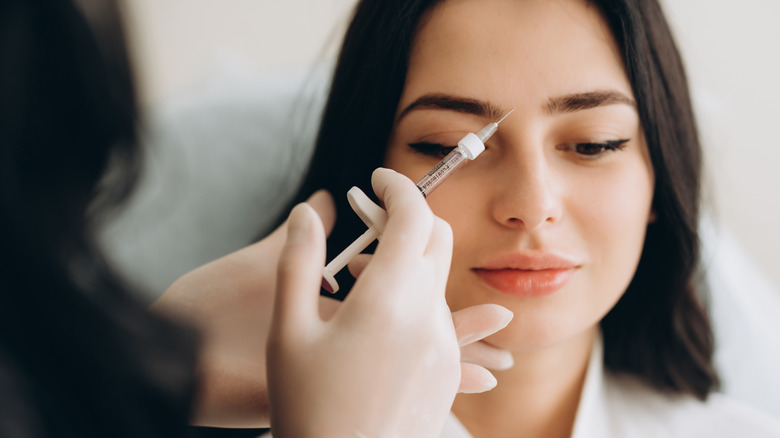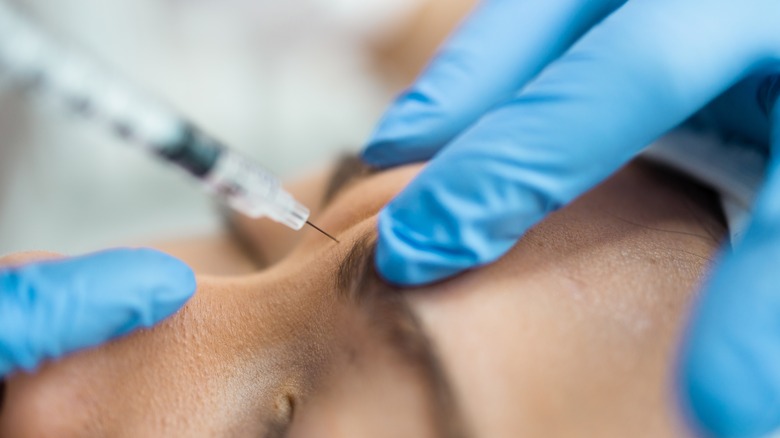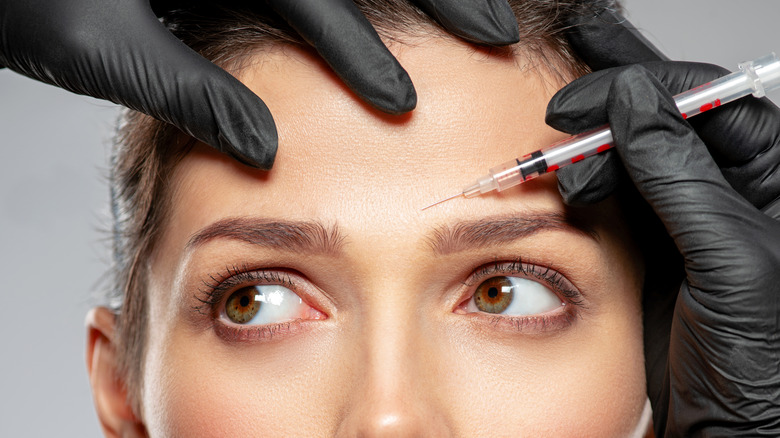What Forehead Filler Is And Why You May Want To Avoid The Risky Procedure
From lip injections to nonsurgical nose jobs, it seems like facial fillers are everywhere these days. Few celebrities admit to having work done, but more and more everyday people are outspoken about getting routine touch-ups, just as plainly as they'd discuss getting their monthly manicures. Love them or hate them, there's no denying that these smoothing treatments are on the rise. According to a recent report by Zion Market Research, the global dermal filler market's worth is expected to reach nearly 12 billion dollars by the year 2030.
With the increasing popularity of injectable treatments, it was only a matter of time before forehead filler would enter the conversation. Prior to the explosive use of fillers in recent years, soft tissue fillers were typically used to add fullness or softness to the lips, under-eyes, and cheeks. "Juvéderm Ultra XC is the original hyaluronic acid filler FDA-approved for lip augmentation. It works well for plumping and adding volume," Dr. David Shafer told Aedit. However, with new names for physical insecurities cropping up seemingly constantly on social media, the forehead has become the latest area of concern targeted by fillers. Still, any cosmetic procedure is not without potential downsides, and forehead filler may be even riskier than similar injectable treatments. But what is forehead filler used for, and how safe is this procedure?
Why some people choose to get forehead filler
The forehead is one of the first areas of the face where people notice signs of aging. Sun damage, expressive movement, and genetics can all play a part in why some experience fine forehead lines faster than others. For many, this isn't a big deal — after all, wrinkles are a sign of a life well-lived, right? But others don't see things quite the same way. "Fillers are an excellent tool for fighting off the aging process and enhancing your appearance," Dr. Rod Rohrich told the American Society of Plastic Surgeons. Selfies, social media, and video conferences are just some of the reasons why many people choose to pursue aesthetic interventions like fillers.
Other reasons why some people choose to get forehead filler aren't quite as straightforward. Forehead fillers, like Juvéderm, can be used in conjunction with other procedures to reduce severe scarring, textural issues, and other unique concerns. According to a study published in The Journal of Clinical, Cosmetic, and Investigational Dermatology, hyaluronic acid fillers can yield favorable results when treating boxcars or rolling acne scars. For deep-set wrinkles and scars, few treatments mirror the effects of facial fillers. Some people also look to forehead facial fillers to fix the appearance of a pronounced brow ridge, but this isn't quite as common.
Here's why forehead filler differs from other injectable treatments
The reality is that every time you choose to have work done, invasive or not, there are potential complications to be aware of. However, forehead filler is especially risky because of the nerves that occupy areas like the glabellar region — also known as the place where "11s," two deep vertical lines between the eyebrows, develop. According to research published in The Journal of Dermatology and Skin Science, the forehead is among the most dangerous areas to inject fillers into. Serious complications, like blindness, tissue necrosis, and stroke, are commonly linked to filler injections placed in the forehead, nose, and glabella.
"Many experts advise caution with [forehead filler] procedures as there's a very real danger of embolizing the supraorbital artery, or its branches, which supply the eye," Dr. Mahsa Saleki tells Refinery29. This complication is technically present with all facial filler, but some areas of the face — like the forehead — are far more high-risk than others. For that reason, there are some medical practitioners who refuse to treat the forehead or surrounding areas of the face with filler.
What to expect from forehead filler treatment
Truth be told, the process of getting forehead filler isn't much different from other filler treatments. If you've never had fillers before, you'll want to ensure that you choose a top-tier provider for the job. Due to the risks associated with forehead filler, selecting an aesthetic professional with long-term experience in treating this area of the face is especially important. Make sure to ask questions about their safety plan should anything go wrong and their rate of success in treating patients with concerns similar to yours.
Your provider will use an injectable dermal filler product like Juvéderm, a gel made from hyaluronic acid. Hyaluronic acid is a naturally occurring substance that our bodies produce on their own. Alternatively, calcium-hydroxyapatite fillers, like Radiesse, can be used to treat the forehead. In a study published by the medical journal Plastic and Reconstructive Surgery Global Open, 100% of participants reported that they were satisfied with the results of their forehead filler treatments.
Here's what people are saying about forehead fillers
When it comes to forehead filler, there are few accounts from verified patients regarding the treatment outcome. One reason for this could be that some providers aren't comfortable performing the procedure and advise their clients against pursuing it. "I asked my surgeon about forehead filler, [but] he said it's risky, and he doesn't do that," one consumer wrote. It's also worth noting that forehead filler is a relatively new intervention, as, according to Google, interest in the term "forehead filler" was practically nonexistent until early 2021.
Outside of serious complications, a common misconception about fillers is that they will make you look "overfilled" or lead to migration — but doctors say there's little truth behind these claims. "Fillers don't ruin your face. They just can't fix everything — and attempting to do so by injecting more and more can look strange," Dr. Heidi Waldorf tells RealSelf. Overfilling or migration is usually the product of improper technique or misguided attempts to "lift" areas of the face using excessive quantities of filler.
Alternatives to facial filler for forehead concerns
So you want to treat forehead concerns like ridges or wrinkles, but you don't want to use facial fillers. No sweat off your brow — there are various procedures that can help soften lines and provide smoother skin without the risk of severe complications like stroke or blindness. One such treatment, microneedling, is commonly used with PRP, or platelet-rich plasma injections. With microneedling, a small roller creates micro-tears in the skin, and a provider uses your own platelets to encourage healthy cell turnover further, resulting in fresh, beautiful-looking skin as it heals. "PRP can be used like a filler. It will stimulate the growth of new tissues and blood vessels in the areas injected," Dr. Leslie Pickens told RealSelf.
Of course, there are also other treatments, like Botox and Dysport, which can soften lines and provide a gentle lifting effect without the risks associated with forehead fillers. "Botox is a wonder drug. It keeps people looking young and when done well and in an experienced practitioner's hands, it looks very natural," Dr. Stafford Broumand told Town & Country. However, neurotoxin-based injectables like Botox aren't without their own set of potential drawbacks. Some of the complications associated with neurotoxins include facial drooping, asymmetry, and weakness, but they're quite rare. Furthermore, you can lower your chances of developing complications by choosing an accredited injector for any injectable services.





